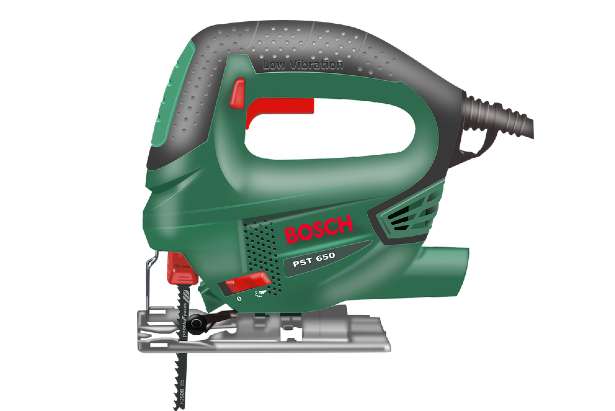Jigsaws are an incredible power tool and can be used to make straight or curved cuts in a variety of materials such as wood, particleboard, plastic, metal, and even ceramic tile. Jigsaw blades come in a range of different shapes and lengths and are usually specially designed to cut one particular material.
In this article, we’re going to explain why jigsaw blades come in different lengths and how to choose the best one for your job. Let’s get started.
Why Do Jigsaw Blades Come in Different Lengths?
Jigsaws operate by quickly sending a jigsaw blade up and down, simulating the cutting motion of a conventional handsaw. They offer fast and easy options for cutting materials and they also have the ability to cut curves and complex shapes.
Depending on the material you’re cutting through, a shorter or longer blade will be better suited for the job. Choosing a blade that is too long or too short can make the job more difficult, and also can be dangerous.
Total Length ‘vs’ Cutting Length
There are two different dimensions to consider before purchasing a jigsaw blade for the task: total length and cutting length. Total length will give you the overall length of the blade.
Cutting length, on the other hand, is the proposed cutting distance the blade can achieve safely as noted by the manufacturer. As a rule of thumb, it is around 1 inch (25mm) less than the Total length of the blade.
As the blade travels up and down, the tip of the blade needs to be below the bottom of the wood piece at all times. If it moves into the wood piece, it can bind against it. This can cause the blade to break.
Also, the blade can bang against the uncut part of the wood and cause the saw to jump. In the worst case, the operator can lose control of the saw. This is a truly dangerous situation!

Choosing the Right Jigsaw Blade Length
Choosing the right jigsaw blade length is important for a few key reasons. The most important of these is safety. Cutting through large sheets of material requires using the jigsaw above the material and the protruding blade will not be visible underneath. If the blade is too long, you are more prone to injury.
The long, protruding blade can easily make contact with some other surface under the material. As a result, it can snap or break. The hot, sharp pieces can fly through the air, bounce, and be propelled towards the operator! Also, the saw can jump and the operator can lose control of it. I wrote another article about dangerous woodworking tools.
If you’re planning on cutting a sheet of plywood that’s only an inch thick, you’re best off using a jigsaw blade designed for cutting wood with a size of around 2 inches long. That way the blade will only cut through the intended material and not protrude too far below the plywood board, reducing the risk of it breaking and causing injury.
Shorter Jigsaw Blades Reduce Excessive Vibration
Another reason for choosing the appropriate blade length is to reduce the force on the blade due to vibration. Let’s use the example of the 1-inch thick plywood board again. If your blade is 8 inches long, there’s at least 5-6 inches not being used and this can lead to excessive vibration in that unused portion of the blade.
Excessive vibration causes difficulty maneuvering the jigsaw, will generate unnecessary heat and stress on the blade, and subsequently makes the blade more prone to breaking. A shorter blade reduces vibration, is safer, and is easier to work with.
Blade Length Affects Jigsaw Performance
The cutting performance of the Jigsaw is also affected by excessive vibration. If your blade is too long, your jigsaw will need to work harder. The jigsaw can then overheat. Also, the accuracy of the cut can be reduced.
Blade Length Affects Cutting Curves
It’s important to choose the right blade length when cutting curves or complex shapes in any material. Jigsaw blades are designed to withstand a lot of vertical force from the cutting movement of the blade. However, due to their thin side profile, they are vulnerable to snapping when sidewards pressure is applied.
Cutting a curve using a jigsaw applies some level of sideways force onto the blade.If the blade is too long, it can flex outwards. This can put it outside of the desired cutting zone.
For more information, see another article I wrote called: What is a Jigsaw?
Conclusion
Choosing the right jigsaw blade length isn’t difficult, although it may seem daunting at first. Remember to allow an extra 1 inch (25mm) of cutting length and your blade will be perfectly sized for the job. Take your time when cutting or using a longer blade and never force or overstress the blade or jigsaw.
Most importantly of all, ensure you’re using the right cutting blade for your material, and don’t forget to always use protective eyewear and other necessary Personal Protective Equipment (PPE) when using a jigsaw.
Di you enjoy this article? If so, you might want to visit my boards on Pinterest. There you can see pins about woodworking, tools, projects, DIY, crafts, and more!
Related Posts:
Can I Use a T-Shank Blade in a U-Shank Jigsaw?
How To Use A Jigsaw To Cut A Hole
Jigsaw vs Router: 15 Pros and Cons


